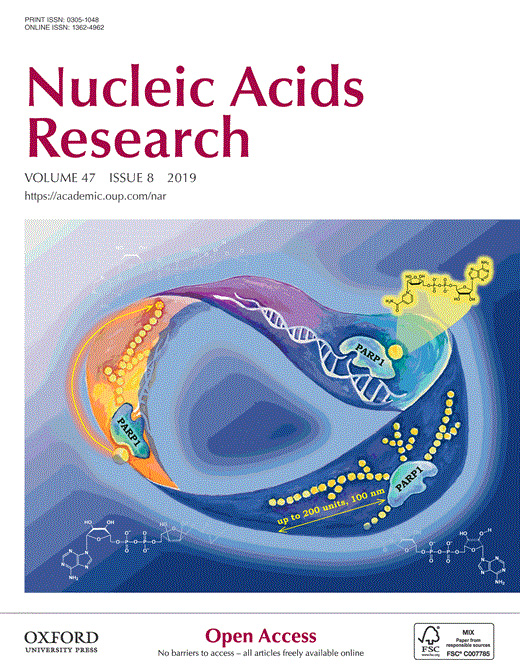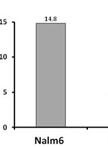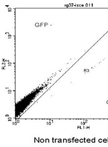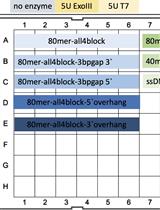- EN - English
- CN - 中文
SMART (Single Molecule Analysis of Resection Tracks) Technique for Assessing DNA end-Resection in Response to DNA Damage
SMART(切除轨迹单分子分析)技术用于评估DNA末端切除对DNA损伤的反应
发布: 2020年08月05日第10卷第15期 DOI: 10.21769/BioProtoc.3701 浏览次数: 5970
评审: Alka MehraImre GáspárFarah Haque
Abstract
DNA double strand breaks (DSBs) are among the most toxic lesions affecting genome integrity. DSBs are mainly repaired through non-homologous end joining (NHEJ) and homologous recombination (HR). A crucial step of the HR process is the generation, through DNA end-resection, of a long 3′ single-strand DNA stretch, necessary to prime DNA synthesis using a homologous region as a template, following DNA strand invasion. DNA end resection inhibits NHEJ and triggers homology-directed DSB repair, ultimately guaranteeing a faithful DNA repair. Established methods to evaluate the DNA end-resection process are the immunofluorescence analysis of the phospho-S4/8 RPA32 protein foci, a marker of DNA end-resection, or of the phospho-S4/8 RPA32 protein levels by Western blot. Recently, the Single Molecule Analysis of Resection Tracks (SMART) has been described as a reliable method to visualize, by immunofluorescence, the long 3′ single-strand DNA tails generated upon cell treatment with a S-phase specific DNA damaging agent (such as camptothecin). Then, DNA tract lengths can be measured through an image analysis software (such as Photoshop), to evaluate the processivity of the DNA end-resection machinery. The preparation of DNA fibres is performed in non-denaturing conditions so that the immunofluorescence detects only the specific long 3′ single-strand DNA tails, generated from DSB processing.
Keywords: DNA repair (DNA修复)Background
Genomic instability is one of the enabling characteristics leading to tumour development (Hanahan and Weinberg, 2011). Many sources of DNA damage, either endogenous or exogenous, induce various DNA lesions including double strand breaks (DBSs), which activate the DNA damage response (DDR)–the cell process aimed at preserving DNA integrity. Two main repair pathways are involved in the DSBs repair: non-homologous end joining (NHEJ) and homologous recombination (HR) (Mao et al., 2008). The HR process prevents the loss of genetic information upon DNA damage through a faithful repair using a complementary DNA sequence. By inhibiting the error prone NHEJ and triggering homology-directed DSB repair, DNA end resection has a crucial function in directing the repair pathway choice towards a faithful repair. So, to promote a correct HR, the DSBs are processed through the DNA end-resection machinery which is necessary to generate the long 3′ single-strand DNA (ssDNA) tails essential for the homologous strand invasion. DNA end-resection is a finely regulated process; the first step consists of the recruitment of the MRN complex (MRE11-RAD50-NBSI) and CtIP (RBBP8) onto the DNA lesions to produce short stretches of ssDNA (Stracker and Petrini, 2011) followed by further end-resection mediated by exonuclease I (EXOI) or DNA replication helicase/nuclease 2 (DNA2) in complex with the Bloom syndrome helicases (BLM) (Nimonkar et al., 2011). Subsequently, the replication protein A (RPA) complex binds the ssDNA generated by DNA end-resection, preventing the formation of DNA hairpins (Chen et al., 2013) and to facilitate the loading of RAD51 required for the strand exchange process (Krogh and Symington, 2004).
The evaluation of DNA end-resection is crucial to dissect the molecular mechanisms underlying this finely tuned process and to identify the key players involved. Various methods can be used to assess the DNA end-resection process indirectly, analyzing phosphorylated S4/8 RPA32 as mentioned above, or RAD51 foci, or detection of BrdU in ssDNA following long incubation time (Tkáč et al., 2016). A method to determine the length of resection and the extent of ssDNA at a specific DSB site was developed in 2014 by Tania Paull, although this is based on the expression of an endonuclease (such as AsiSI) to induce DSBs at specific sites within the genome, which is then followed by PCR analysis (Zhou et al., 2014).
The SMART assay was first developed by Huertas and co-authors as a reliable method to measure the length of resected DNA following exposure to any damaging agent in any cellular system, at the level of single molecules (Cruz-García et al., 2014). The assay was based on the previously developed DNA combing assay, which enables the physical stretching of DNA fibres onto a solid support allowing visualization through immunofluorescence (Alfano et al., 2016 and 2017). We recently identified the RNA binding protein HNRNPD as a new player in the HR process and used the SMART assay, along with other techniques, to evaluate DNA end-resection (Alfano et al., 2019). We pulse-labeled HeLa cells with the halogenated IdU (5-Iodo-2′-deoxyuridine)–although any other pyrimidine analogue can be used, such as BrdU (Bromodeoxyuridine)or CldU (5-Chloro-2'-deoxyuridine)–which is incorporated during S phase into the newly synthesized DNA, for approximately 24 h followed by treatment with the DNA damaging agent, camptothecin. At the end of drug incubation time, cells were lysed and the DNA fibres were extracted in non-DNA denaturing conditions (avoiding hydrochloric acid treatment); this is an important criterion for the assay, because the anti-BrdU antibody is able to recognize the DNA-incorporated IdU only when DNA is in the single strand conformation, as is the end-resected DNA. Through the SMART assay, it is possible to visualize the long 3′ single-strand DNA tails and measure the DNA tracts evaluating the efficiency of the endogenous resection machinery without genetic manipulations. Finally, this technique can be used in any model cellular system from bacteria to humans.
The DNA fibres, stretched on a microscope slide, and challenged with the anti-BrdU Ab and the secondary fluorescinated Ab were then visualized through immunofluorescence microscopy. Analysis through the SMART assay allowed us to quantify the amount of resected DNA: by using an image analysis software (Photoshop CS5), we were able to measure the length of the DNA fibre tracts analysing the efficiency of the DNA end-resection machinery.
Materials and Reagents
- 6 cm dish (Corning Inc., catalog number: 430166 )
- Silane Prep-slide (Sigma-Aldrich, catalog number: S4651 )
- HeLa cells (ATCC, CCL2 , catalog number: CCL2 )
- Anti-BrdU clone BU1/75 (ICR1) (AbdSerotec, catalog number: OBT0030CX )
- Alexa Fluor 488-conjugated chicken anti-rat (Thermo Fisher Scientific, catalog number: A-21470 )
- Anti phospho-RPA32 S4/8 antibody (Bethyl Laboratories, catalog number: A300-245 )
- Roswell Park Memorial Institute (RPMI) 1640 Medium (Thermo Fisher Scientific, catalog number: 11875093 )
- 10% fetal bovine serum (FBS), EU Approved (South American) (Thermo Fisher Scientific, GibcoTM, catalog number: 10270-106 )
- Penicillin-streptomycin (Thermo Fisher Scientific, GibcoTM, catalog number: 15070-063 )
- Trypsin-EDTA (Thermo Fisher Scientific, catalog number: 25200056 )
Note: HeLa cells were cultured in RPMI 1640 supplemented with 10% FBS, 1 μg/ml penicillin and 1 µg/ml streptomycin. - 5-Iodo-2′-deoxyuridine (IdU) (Sigma-Aldrich, catalog number: I7125 , storage at 4 °C)
- (S)-(+)-Camptothecin (CPT) (Sigma-Aldrich, catalog number: C9911 , storage at -20 °C)
- Sodium dodecyl sulphate (SDS) (Sigma-Aldrich, catalog number: 71725 , storage at RT)
- TRIS (Sigma-Aldrich, catalog number: 17926 , storage at RT)
- EDTA 0.5 M pH 8.0 (Thermo Fisher Scientific, catalog number: AM9262 , storage at 4°C)
- Sodium phosphate dibasic (Na2HPO4) (Sigma-Aldrich, catalog number: 255793 , storage at RT)
- Potassium phosphate monobasic (KH2PO4) (Sigma-Aldrich, catalog number: P0662 , storage at RT)
- Potassium Cloride (KCl) (Sigma-Aldrich, catalog number: P9541 , storage at RT)
- Hydrochloric acid 39.5% (HCl) (Carlo Erba Reagents, catalog number: 405761 , storage at RT)
- Methanol (Carlo Erba Reagents, catalog number: 528101 , storage at RT)
- Acetic Acid Glacial (Carlo Erba Reagents, catalog number: 401424 , storage at RT)
- Ethanol Absolute (Carlo Erba Reagents, catalog number: 414607 , storage at RT)
- Bovine Serum Albumine (BSA) (Sigma-Aldrich, catalog number: A9418 , storage at 4 °C)
- Sodium Chloride (NaCl) (Sigma-Aldrich, catalog number: S9888 , storage at RT)
- ProLong Gold Antifade Reagent (Thermo Fisher Scientific, catalog number: P36935 , storage at RT)
- Phosphate buffered saline (PBS) (see Recipes)
- Spreading buffer (see Recipes)
Equipment
- Zeiss Axiovert LSM100M confocal microscope (Carl Zeiss, Germany)
- CO2 incubator (Panasonic, catalog number: MCO-18AC )
- Centrifuge
Software
- Adobe Photoshop CS5
- GraphPad Prism 8 software
Procedure
文章信息
版权信息
© 2020 The Authors; exclusive licensee Bio-protocol LLC.
如何引用
Altieri, A., Dell'Aquila, M., Pentimalli, F., Giordano, A. and Luigi, A. (2020). SMART (Single Molecule Analysis of Resection Tracks) Technique for Assessing DNA end-Resection in Response to DNA Damage. Bio-protocol 10(15): e3701. DOI: 10.21769/BioProtoc.3701.
分类
癌症生物学 > 基因组不稳定性及突变 > 生物化学试验 > DNA结构和改变
分子生物学 > DNA > DNA 损伤和修复
您对这篇实验方法有问题吗?
在此处发布您的问题,我们将邀请本文作者来回答。同时,我们会将您的问题发布到Bio-protocol Exchange,以便寻求社区成员的帮助。
Share
Bluesky
X
Copy link
















